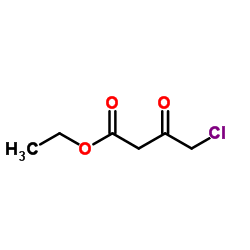Asymmetric reduction of ethyl 4-chloro-3-oxobutanoate to ethyl (R)-4-chloro-3-hydroxybutanoate with two co-existing, recombinant Escherichia coli strains.
Ying Liu, Zhinan Xu, Keju Jing, Xiaoxia Jiang, Jianping Lin, Fang Wang, Peilin Cen
Index: Biotechnol. Lett. 27(2) , 119-25, (2005)
Full Text: HTML
Abstract
Two recombinant strains, E. coli M15 (pQE30-alr0307) and E. coli M15 (pQE30-gdh0310), which were constructed to express, respectively, an NADPH-dependent aldehyde reductase gene and a glucose dehydrogenase gene, were mixed in an appropriate ratio and used for the asymmetric reduction of ethyl 4-chloro-3-oxobutanoate to ethyl (R)-4-chloro-3-hydroxybutanoate. The former strain acted as catalyst and the latter functioned in NADPH regeneration. The biotransformation was completed effectively without any addition of glucose dehydrogenase or NADP+/NADPH. An optical purity of 99% (ee) was obtained and the product yield reached 90.5% from 28.5 mM: substrate.
Related Compounds
| Structure | Name/CAS No. | Molecular Formula | Articles |
|---|---|---|---|
 |
Ethyl 2-Chloroacetoacetate
CAS:638-07-3 |
C6H9ClO3 |
|
Construction of a two-strain system for asymmetric reduction...
2006-03-01 [Appl. Microbiol. Biotechnol. 70(1) , 40-6, (2006)] |
|
Purification and characterization of an alpha-haloketone-res...
2003-10-01 [Biosci. Biotechnol. Biochem. 67(10) , 2145-53, (2003)] |
|
A novel carbonyl reductase from Pichia stipitis for the prod...
2009-04-01 [Biotechnol. Lett. 31(4) , 537-42, (2009)] |
|
Biosimulation of drug metabolism—A yeast based model
2009-01-01 [Eur. J. Pharm. Sci. 36(1) , 157-70, (2009)] |
|
Enantioselective bioconversion using Escherichia coli cells ...
2010-09-01 [J. Microbiol. Biotechnol. 20(9) , 1300-6, (2010)] |